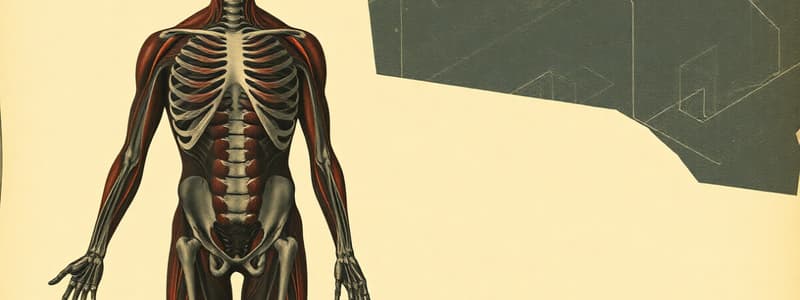Podcast
Questions and Answers
Which type of muscle is classified as voluntary?
Which type of muscle is classified as voluntary?
- Cardiac muscle
- Skeletal muscle (correct)
- Both smooth and cardiac muscle
- Smooth muscle
What is the basic structural and functional unit of a skeletal muscle?
What is the basic structural and functional unit of a skeletal muscle?
- Myofibril
- Sarcomere (correct)
- Cell
- Sarcoplasm
Which of the following is NOT a function of the muscular system?
Which of the following is NOT a function of the muscular system?
- Communication
- Movement
- Respiration
- Absorption (correct)
What does the term extensibility refer to in muscles?
What does the term extensibility refer to in muscles?
Which structure of the muscle fiber is crucial for regulating intracellular calcium levels?
Which structure of the muscle fiber is crucial for regulating intracellular calcium levels?
Which function is primarily responsible for maintaining posture?
Which function is primarily responsible for maintaining posture?
Which of the following is involved in the contraction of the heart?
Which of the following is involved in the contraction of the heart?
How does the muscular system contribute to respiration?
How does the muscular system contribute to respiration?
Which of these muscles is classified as voluntary?
Which of these muscles is classified as voluntary?
What is the basic structural and functional unit of a skeletal muscle?
What is the basic structural and functional unit of a skeletal muscle?
Which function is NOT associated with the muscular system?
Which function is NOT associated with the muscular system?
Which definition accurately describes extensibility?
Which definition accurately describes extensibility?
Which structure within the muscle fiber is crucial for regulating intracellular calcium levels?
Which structure within the muscle fiber is crucial for regulating intracellular calcium levels?
Which type of muscle tissue can contract without involuntary control?
Which type of muscle tissue can contract without involuntary control?
What component is primarily responsible for muscle contraction?
What component is primarily responsible for muscle contraction?
Which protein is primarily involved in muscle contraction by sliding over myosin?
Which protein is primarily involved in muscle contraction by sliding over myosin?
Which function of the muscular system is primarily responsible for keeping us upright?
Which function of the muscular system is primarily responsible for keeping us upright?
What is the role of skeletal muscle during respiration?
What is the role of skeletal muscle during respiration?
What by-product is produced by the contraction of skeletal muscles?
What by-product is produced by the contraction of skeletal muscles?
How do muscles contribute to communication?
How do muscles contribute to communication?
What is the function of smooth muscle contraction?
What is the function of smooth muscle contraction?
Which property of muscle tissue refers to its ability to shorten forcefully?
Which property of muscle tissue refers to its ability to shorten forcefully?
Which of the following is NOT a function of the muscular system?
Which of the following is NOT a function of the muscular system?
What effect does cardiac muscle contraction have on the heart?
What effect does cardiac muscle contraction have on the heart?
What is the characteristic of muscle tissue that allows it to be stretched beyond its normal resting length and still contract?
What is the characteristic of muscle tissue that allows it to be stretched beyond its normal resting length and still contract?
Which protein forms the thick myofilament in muscle fibers?
Which protein forms the thick myofilament in muscle fibers?
Which layer surrounds each fascicle within a skeletal muscle?
Which layer surrounds each fascicle within a skeletal muscle?
What structure in a muscle cell is responsible for storing calcium ions?
What structure in a muscle cell is responsible for storing calcium ions?
What is the functional property of muscle tissue that allows it to return to its original length after being stretched?
What is the functional property of muscle tissue that allows it to return to its original length after being stretched?
In a sarcomere, where are the actin filaments located?
In a sarcomere, where are the actin filaments located?
What is the name of the fibrous covering that surrounds a whole muscle?
What is the name of the fibrous covering that surrounds a whole muscle?
What component is considered a calcium regulatory molecule in muscle contraction?
What component is considered a calcium regulatory molecule in muscle contraction?
Which of the following is NOT a functional property of muscle tissue?
Which of the following is NOT a functional property of muscle tissue?
What best describes the arrangement of myofilaments within each myofibril?
What best describes the arrangement of myofilaments within each myofibril?
Flashcards are hidden until you start studying
Study Notes
Muscular System Functions
- The muscular system is responsible for body movement, maintaining posture, respiration, producing body heat, communication, constriction of organs and vessels, and contraction of the heart.
- Skeletal muscles attached to bones are responsible for the majority of body movements.
- Skeletal muscles maintain tone, which keeps us sitting and standing erect.
- Contraction of the skeletal muscle of the thorax and diaphragm facilitates respiration.
- Contraction of skeletal muscle produces heat as a byproduct.
- The muscular system is involved in all aspects of communication.
- Contraction of smooth muscle within the walls of internal organs and vessels causes constriction of these structures.
- Contraction of cardiac muscle causes the heart to beat.
Functional Properties of Muscle Tissue
- Contractility: The ability of muscle to shorten forcefully.
- Muscle shortening is forceful, while muscle lengthening is passive.
- Excitability: A muscle can be stimulated by a nerve to contract.
- Extensibility: A muscle can be stretched beyond its normal resting length and still be able to contract.
- Elasticity: The ability of the muscle to return to its original resting length after it has been stretched.
Studying That Suits You
Use AI to generate personalized quizzes and flashcards to suit your learning preferences.




